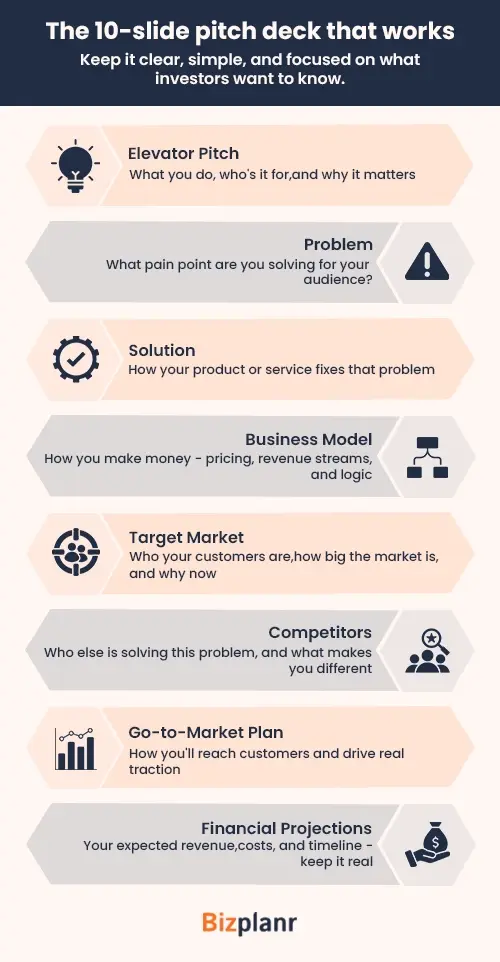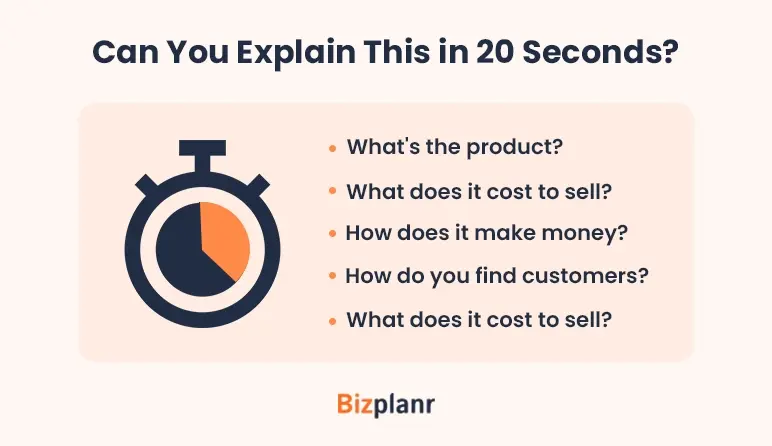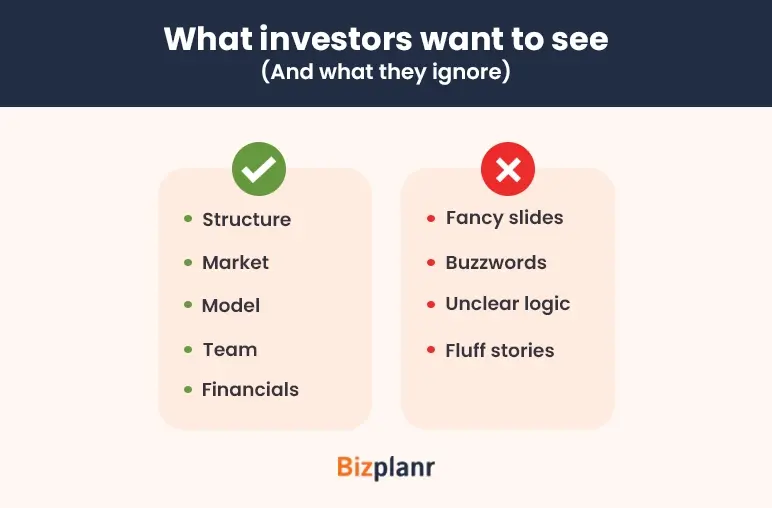At least one pitch deck in the world featured a slide about a dog’s Instagram. True story. The investors smiled, nodded, and immediately invested… in leaving. 🙁
Well…it was a rough start, but it proved a point: What works in pitching a business idea isn’t creativity for creativity’s sake. Its structure. A good pitch lays out the business idea, describes the target market, and shows how the money adds up.
That’s what investors care about, not flashy slides or filler stories. This post focuses on precisely that: How to pitch a business idea that makes sense.
How to pitch a business idea to investors (start to finish)
Alright, so flashy slides aren’t the answer. What matters most is preparation for pitch creation and the pitch content.
Here we’ve covered these two broad aspects to help you understand how to pitch a business idea:
Start with preparation
Before building slides or talking about “the vision,” take care of the basics. And by basics, we don’t mean typing a few sentences into a pitch deck template and calling it a day.
This is about understanding the business, not just the product, but the structure, the market, the opportunity, and how it all works together. Before you pitch, you need to validate your business idea. If the foundation isn’t solid, no amount of design will fix it.
1) Know your business model
How does the company make money? What’s the pricing strategy? What are the revenue streams, and how do they scale? If you need five minutes, a spreadsheet, and a flowchart to explain your sales process or pricing logic, the business pitch isn’t ready.
Investors want to hear a clear explanation of how the company turns an idea into revenue. Add in customer acquisition costs if you know them. That shows you're thinking like someone who’s done their due diligence and is prepared for serious investment conversations.
2) Understand your target market
Who are your potential customers? What pain point are they dealing with? What’s their current solution, and why isn’t it good enough? Saying your audience is “anyone online” doesn’t cut it.
Tailor your research to describe your actual market and show that you’ve focused on a real group of people with real needs. This is how you prove your idea is based on insight and not on general assumptions.
3) Study your competition
There are always competitors. Maybe not with the same exact product or service, but someone is trying to solve the same problem. If you say there’s “no competition,” investors will either assume you haven’t done your research or that there’s no demand.
Explain where your company fits, what your competitive advantage is, and how your business idea is positioned to deliver more value than what’s already out there. That’s the kind of thinking potential investors expect from entrepreneurs doing real work.
4) Define your value proposition
Be specific. What’s the actual problem? Who needs it solved? Why is your solution the right one? If that’s not nailed down, nothing else in the pitch is going to land, no matter how prepared you feel.
Your ability to effectively communicate this upfront is what turns a decent elevator pitch into a compelling story that investors remember.
5) Get honest feedback
Don’t make the investor meeting your first test run. Practice by pitching it to someone who’ll actually call out what’s confusing. If it doesn’t land with them, it won’t land with people holding a checkbook.
Practice with someone who’ll challenge your thinking, question your assumptions, and help you prepare for real questions about your business plan, exit strategy, or investment use—all things potential investors care about.
Start with the pitch deck creation
Now that the prep’s handled, let’s talk about what should actually go into the pitch. Whether you're presenting live or sending over a deck, these are the parts that need to be clear—especially if you want potential investors to stay interested.
Elevator pitch
This is your quick hit. What’s the business idea, who’s it for, and why should anyone care? Keep it tight and actually say something. If potential investors or potential customers don’t understand the company in 20 seconds, they won’t stick around for more examples or details.
“You might have the world's most wonderful idea and business model, but unless you can tell your story in a single sentence, I doubt your venture will succeed.”
— Richard Harpin, founder of HomeServe, via The Times
Harpin’s point is dead-on. If you can’t explain your business idea quickly, your audience will move on. An elevator pitch is your first proof that you can tell your story and that you know what you’re doing.
Problem and solution
What’s the real pain point your audience deals with, and how do you fix it? You're not just offering a service. You're presenting a reason to care. Use specific details that show you understand the problem and why your idea is the right one to solve it.
Business model
How does the company make money? Break down your pricing strategy, where the revenue comes from, and what it costs to acquire a customer. This is your chance to show strategic thinking and business clarity. No one invests in a company without a working plan to create value.
Target market
Who exactly are your customers? “Everyone with Wi-Fi” isn’t a strategy. Describe your target audience in a way that proves you’ve done your research and understand who your service is really for. A pitch that fails to define its potential customer base will lose credibility fast, especially with investors who expect precision.
Competitive advantage
There are always competitors. What matters is how your idea stands out. Whether it’s pricing, experience, or timing, explain what gives your company an edge. If a potential customer had three tabs open—yours and two others—why would they choose you?
Marketing plan
How are you reaching your audience? What’s your plan to attract and convert potential customers? Skip “we’ll go viral” and focus on the actual strategy. Think about sales channels, partnerships, content, or anything that helps support your message and create traction with the right people.
Financial projections
No one’s asking you to predict the next five years down to the dollar. But you should present numbers that show how you think. Investors want to see how you expect to grow, what kind of costs you’ll manage, and how this investment supports the company’s future.
Team background
Who’s building this company, and why are they right for it? Talk about each team member’s relevant experience and industry expertise. You don’t need to list full résumés. Just show that the entrepreneurs behind the pitch have the skills to execute and the context to succeed.
The ask
Now say what you want. How much are you raising, and what will it go toward? If there’s an exit strategy, include it. Investors expect transparency around the use of funds, ownership, and how the company plans to move toward a return. Don’t make them dig for such information.
Finally, build a pitch deck that doesn’t confuse people.
How to get the pitch deck right the first time?
If you want to get your pitch deck correct, the first time, let’s get a few things straight.
Keep it short but not vague
A decent pitch deck is usually 10 to 12 slides. That’s enough space to explain your business idea without dragging anyone through a presentation that feels like a group project gone too far.
Each slide should cover one thing. If you’re trying to fit your entire marketing plan, pricing model, and hiring strategy onto a single slide, you’re being confusing.
Use slides like a human
Your slides should support what you’re saying. If you need to say something, say it out loud. Don’t stuff it into a wall of text, thinking investors will read while you talk over it.
Use big, readable text, a few graphs or charts where they actually help, and skip anything that looks like it belongs in a corporate brochure. A well-crafted deck should help entrepreneurs communicate clearly and deliver their message without losing the audience.
Put things in an order that makes sense
You don’t need to reinvent the entire format of the pitch deck. Most successful decks follow a version of this flow because it’s built around how people absorb information:
- Elevator pitch: What’s the business, who’s it for, and why it exists?
- Problem: What issue are your customers dealing with?
- Solution: How your business fixes it.
- Business model: How you make money. Pricing, revenue streams, and acquisition costs.
- Target market: Who you’re selling to, how big the market is, and why now.
- Competitors: Who else is solving this, and what makes your approach better? (Saying “we have no competition” is the fastest way to lose credibility.)
- Go-to-market plan: How you’ll reach customers and get them to care.
- Financial projections: Revenue, costs, timeline. It doesn’t have to be perfect, just has to make sense.
- Team: Who’s behind the business, and why are they the right people to build it?
- The ask: How much you’re raising, what it’s for, and what the return could look like.
That’s the core. If you’ve got early traction, test users, paid pilots, or anything else that shows progress, include it. It helps prove that you’re not just pitching an idea, you’re building something that already has signs of success.
Pitch the business confidently
Investors want to hear from someone who knows the business. Someone who can present the big picture, explain the details, and effectively communicate the value behind the idea.
Your deck is there to keep things structured. Use it to stay on track, not to read from. A great pitch comes from founders who practice, know their company, and don’t need to lean on slides to answer a tricky question.
You’ve done the research. You can explain your business idea in plain terms. You know your market, your value, and how this company can grow. You’re showing why this is worth the investment and why you’re the one to create and lead it.
By the end of the pitch, your audience should understand what the business does, who it’s for, how it plans to grow, and why your team is the one to do it. If they walk away interested and ask for more, that’s what success looks like.
Jamie Siminoff, founder of Ring doorbells, initially faced rejection on Shark Tank. However, a chance encounter with Richard Branson led to a successful pitch and subsequent investment. Branson emphasized the value of simplicity in pitches.
“When I hear pitches, the founders that really impress me are the ones who can keep it simple and snappy.” — Richard Branson, as reported by The Times
This example highlights how clarity and brevity can make a significant impact
Not sure what goes where? There’s a fix for that
Starting a pitch deck from scratch can feel like a lot.
Using a free investor pitch template gives you a solid framework to work with. It shows you exactly where to place your elevator pitch, how to present your value proposition, and what key business plan details to include. You’re not left guessing what investors expect.
For entrepreneurs who want to create something professional without wasting time, it’s one of the most helpful resources out there. And once the structure is handled, you can focus on practice, which is what leads to a perfect pitch.
Think of the free pitch deck template as the startup version of an online course. It gives you the structure, you bring the insight.
Conclusion
A good pitch doesn’t end when the slides do. What happens after is when things start to count. If someone’s interested, you’ll be asked to follow up, share more resources, or go deeper into the numbers. That’s when the real conversations begin.
And if they’re not? You still walk away with feedback, not just a no, but a few clues about what to tighten, what to explain better, or what part of your business idea didn’t land with the audience.
Smart entrepreneurs treat the business pitch as an ongoing process, something you improve with every round of feedback. They don’t just present once and hope. They test, revise, and improve the way they explain the idea until it actually connects.
If you want help refining the structure or tightening your message, Bizplanr is a great starting point. It’s built to help founders create a pitch that’s clear, focused, and ready for honest investor conversations.
Success doesn’t mean saying everything. It means saying the right things clearly and confidently. You’re giving potential investors a real reason to take your business seriously. That’s the point. That’s the win.
Get Your Business Plan Ready In Minutes
Answer a few questions, and AI will generate a detailed business plan.
Frequently Asked Questions
Do I need a full business plan before pitching?
Not always. Many investors, especially angel investors, are fine with a pitch deck that clearly explains your business idea, financials, and go-to-market approach. But if they’re interested, they may ask for a thorough business plan during due diligence.
What if I don’t have revenue yet? Can I still pitch?
Yes. Many early-stage entrepreneurs pitch without revenue, but you’ll need to show real thinking behind your idea. Talk about the problem you’re solving, and the solution you’re building, and give a clear path to revenue. Even a small win or an early user test is a useful example.
How detailed should my financial projections be?
Your projections don’t need to be overly complex, but they should be realistic. Break down your expected revenue, major costs, and how long the investment will last. What matters more than numbers is the thinking behind them and whether you’ve done your research.
Should I include ownership percentages in my pitch?
You don’t need to put this in the deck, but you should be ready to explain it. Once potential investors are interested, they’ll ask about equity, co-founders, and how ownership is structured.
How long should my pitch be during a live meeting?
Keep your pitch between 7 and 10 minutes. That’s enough time to cover your business idea, team, market, and financials without rushing. Save time for Q&A. Real interest shows up in the questions, not just the slides.








